When you think about death you also start to think about life.
A lust for life wells up inside.
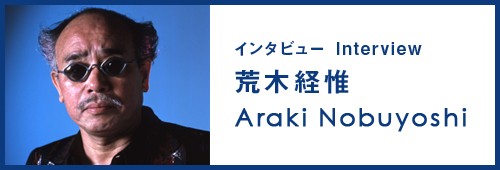
The opening of Araki Nobuyoshi’s solo exhibition 2THESKY, my Ender was thronged with guests yet at the same time evocative of the living funeral of the title. What kind of message lies within the some 150 new works that filled the venue and the photobook of the same title, which Araki himself has referred to as ‘the testament of a photographer who presentiments death’?
Interview/text: Kitazawa Hiromi
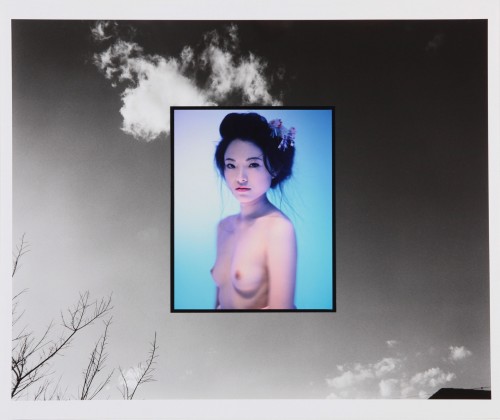
2THESKY, my Ender 2009 Collage on b&w photograph, 50.8 x 60cm
2THESKY, my Ender is a large 200-page photobook in B4 format containing a series of works created as a diary starting with the first calligraphy of the year on 2 January 2009 and ending on 15 August the same year by Araki, who had a brush with death when he underwent surgery in the fall of 2008 after being diagnosed with prostate cancer. He produced even more work for the exhibition, where Arakinema, a film based on the works on display, is also being screened. The works consist of photographs of the sky upon which Araki has used various techniques including painting, calligraphy, and collage to express everyday thoughts and events, but hanging over them all is the artist’s premonition of ‘death’.
“I thought the god of death had crept up on me, but looking at the results, they include a lot of females, ie goddess figures, who are protecting me from death. Although most of these goddesses are in bondage.”
The deaths of his father (1967), his mother (1974), and his beloved wife, Yoko (1990), each had a huge impact on Araki the photographer as well as causing him great sadness. And last year, the prospect of his own death, which he experienced for the first time, shocked him to such an extent that he felt compelled to create his own ‘posthumous work’.
The sky as film
The ‘2THESKY’ in the title alludes to Araki’s conviction that photographs are a secondary thing, not creation but an imitation or counterfeit of reality, and expresses his desire to create ‘another sky that is mine’ by writing in the sky.
“After the death of my wife, Yoko, all I did was take photographs of the sky from my balcony, because if it’s not the sky from your own balcony it’s not the real sky, is it. This time I composed everything in the sky, as if the sky was the film. I copied things and wrote calligraphy over the top of these photographs so that the results were a kind of diary etched into film in the form of the sky. Until now I’ve referred to the sky as a mirror or a window reflecting my own soul, but this time I used the sky as a canvas and I realized that the sky itself is now the film.”
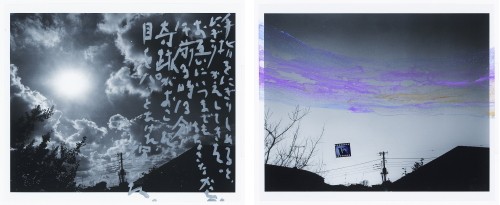
2THESKY, my Ender 2009
Left: Acrylic on b&w photograph, 50.8 x 60cm 27 January (the anniversary of his wife’s death)
Right: Mixed media on b&w photograph, 50.8 x 60cm 7 July (his wedding anniversary)
The works include black and white photographs of the sky over which Araki has collaged photographs or polaroids of those who have passed away or written excerpts from death notices or news articles or, on the anniversary of Yoko’s death, things written when she died, so that they reflect both the events that occurred and Araki’s mood at the time.
“Because I do them not in a studio or anything but at home, I don’t have anywhere to dry them and so the most I can do in a single day is around eight pieces. Although if I had the room I could do more. My output varies from day to day, but the important thing is to produce something regardless of whether it’s a good day or a bad day. It’s no good working only on good days, or only with the good bits, or only photographing beautiful things. Because you’ve got to remember that there are all kinds of things, both good and bad.”
As a result of recording and expressing these events and moods, it seems that Araki’s feelings about life and death became clearer.
From death to life
“I paint over black and white photographs of the sky. I also like just placing a brush down and lifting it off to create something like a Rorschach inkblot or flinging white Liquitex at the photo. I’ve always thought this, but to me black and white signify death, and adding color signifies breathing life into a work. Which is why photographs have a life of their own.”
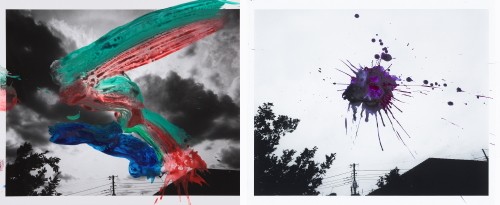
2THESKY, my Ender 2009 Acrylic on b&w photograph, 50.8 x 60cm (each)
The ‘red’ that features in some of the most memorable of these latest painted works has a blackish tinge and could almost be described as the color of blood. It could also be seen as symbolizing aspects of the scenery in Araki’s mind’s eye, such as wounds, pain, uncertainty, and fear. This color is depicted even more vividly in Arakinema.
“By some strange coincidence, a nude photograph of me as a baby appeared from somewhere. I guess I’ve been kind of cute from way back then. Anyway, we put this at the end of the photobook, as if to say I was about to set out on a new life. When you think about death you also start to think about life. A lust for life wells up inside…”
The diary also includes a collaged work featuring a newspaper article about Araki entitled “Lust for life increased”. The contents of the article are summed up in the following comment by Araki:
“I’m fully prepared for death, now, regardless of when it strikes! There’s nothing backward-looking about such thoughts. It’s as if I’ve been given a new lease on life!”
The Araki of 2010
Having experienced a strong presentiment of his own death and recorded and presented his own feelings about this in the form of a ‘posthumous work’, it seems Araki has already taken steps in setting about life.
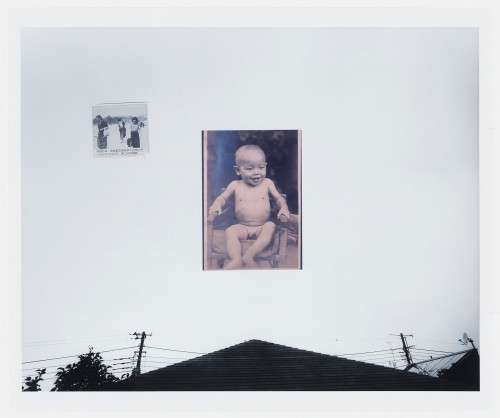
2THESKY, my Ender 2009 Collage on b&w photograph, 50.8 x 60cm
“Recently I’ve been photographing flowers against backdrops consisting of my own action paintings. Next year [interview conducted end 2009] I’ve got a major solo exhibition in Austria and some publication work in Mexico lined up, and in May I’ll turn 70. I’d like to return to the starting point and produce the kind of work that speaks to the essence of photography.”
For Araki, this living posthumous exhibition is more like a celebration of his renaissance than a farewell, although to reach this point took more than a year, during which time he faced the prospect of his own death, looked at it squarely, and depicted everything he saw. In addition, the ‘life’ Araki will capture from this stage forward will no doubt be deeper and emit an intense energy on account of his acute awareness of ‘death’.
Araki Nobuyoshi, photographer, has confirmed that for him, life is all about continuing to take photographs. 2THESKY, my Ender leaves one with a strong sense of his determination to carry on taking photographs in the future.
Araki Nobuyoshi
Born 1940 in Tokyo. From a ‘camera=self’ approach to photography focusing on his personal life and the quotidian, Araki’s sea of works include graphic portrayals of his concerns with Eros (life, sex) and Thanatos (death) taking women and flowers as their subjects; alleys and street corners filled with the lyricism of life; and his Japanese Faces project documenting the nation by inviting the public to have their portraits taken. His photobooks now number more than 400. The publication of his most recent, 2THESKY, my Ender (Shinchosha), is being celebrated with a solo show of the same title through 9 January at the Taka Ishii Gallery. Forthcoming exhibitions include Araki Nobuyoshi and Funakoshi Katsura: An Image of Love Supreme (9 January – 4 April at the Takahashi Collection Hibiya) and Nobuyoshi Araki: Shojo Sekai (World of Girls) (12-30 January at Gallery Hashimoto).
http://www.arakinobuyoshi.com/
All images courtesy Shinchosha and Taka Ishii Gallery
